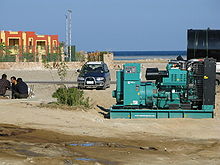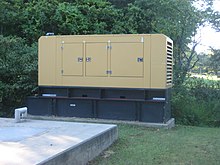
Back Dieselgenerátorová stanice Czech Generador diésel Spanish Diiselgeneraator Estonian دیزل ژنراتور Persian Polttomoottorivoimalaitos Finnish Дизельді электр станциясы Kazakh ಡೀಸಲ್ ನ್ನು ವಿದ್ಯುಚ್ಛಕ್ತಿಯನ್ನಾಗಿ ಪರಿವರ್ತಿಸುವ ಯಂತ್ರ Kannada 디젤 발전기 Korean Dieselaggregat NN Dieselaggregat NB
This article has multiple issues. Please help improve it or discuss these issues on the talk page. (Learn how and when to remove these messages)
|


A diesel generator (DG) (also known as a diesel GenSet) is the combination of a diesel engine with an electric generator (often an alternator) to generate electrical energy.[1] This is a specific case of an engine generator. A diesel compression-ignition engine is usually designed to run on diesel fuel, but some types are adapted for other liquid fuels or natural gas (CNG).[2]
Diesel generating sets are used in places without connection to a power grid or as an emergency power supply if the grid fails, as well as for more complex applications such as peak-lopping, grid support, and export to the power grid.[2]
Diesel generator size is crucial to minimize low load or power shortages. Sizing is complicated by the characteristics of modern electronics, specifically non-linear loads. Its size ranges around 50 MW and above, an open cycle gas turbine is more efficient at full load than an array of diesel engines, and far more compact, with comparable capital costs; but for regular part-loading, even at these power levels, diesel arrays are sometimes preferred to open cycle gas turbines, due to their superior efficiencies.